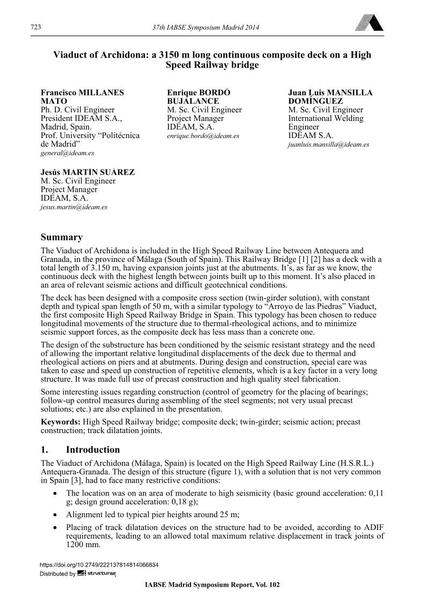Viaduct of Archidona: a 3150 m long continuous composite deck on a High Speed Railway bridge

|
|
|||||||||||
Bibliographic Details
| Author(s): |
Francisco Millanes Mato
Enrique Bordó Bujalance Juan Luis Mansilla Domínguez Jesús Martín Suárez |
||||
|---|---|---|---|---|---|
| Medium: | conference paper | ||||
| Language(s): | English | ||||
| Conference: | IABSE Symposium: Engineering for Progress, Nature and People, Madrid, Spain, 3-5 September 2014 | ||||
| Published in: | IABSE Symposium Madrid 2014 | ||||
|
|||||
| Page(s): | 723-730 | ||||
| Total no. of pages: | 8 | ||||
| Year: | 2014 | ||||
| DOI: | 10.2749/222137814814066834 | ||||
| Abstract: |
The Viaduct of Archidona is included in the High Speed Railway Line between Antequera and Granada, in the province of Málaga (South of Spain). This Railway Bridge [1] [2] has a deck with a total length of 3.150 m, having expansion joints just at the abutments. It’s, as far as we know, the continuous deck with the highest length between joints built up to this moment. It’s also placed in an area of relevant seismic actions and difficult geotechnical conditions. The deck has been designed with a composite cross section (twin-girder solution), with constant depth and typical span length of 50 m, with a similar typology to “Arroyo de las Piedras” Viaduct, the first composite High Speed Railway Bridge in Spain. This typology has been chosen to reduce longitudinal movements of the structure due to thermal-rheological actions, and to minimize seismic support forces, as the composite deck has less mass than a concrete one. The design of the substructure has been conditioned by the seismic resistant strategy and the need of allowing the important relative longitudinal displacements of the deck due to thermal and rheological actions on piers and at abutments. During design and construction, special care was taken to ease and speed up construction of repetitive elements, which is a key factor in a very long structure. It was made full use of precast construction and high quality steel fabrication. Some interesting issues regarding construction (control of geometry for the placing of bearings; follow-up control measures during assembling of the steel segments; not very usual precast solutions; etc.) are also explained in the presentation. |
||||
| Keywords: |
composite deck precast construction high-speed railroad bridge seismic action twin-girder track dilatation joints
|
||||
